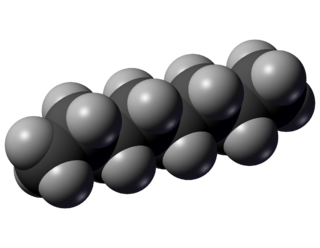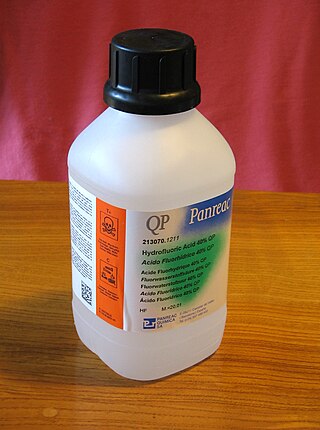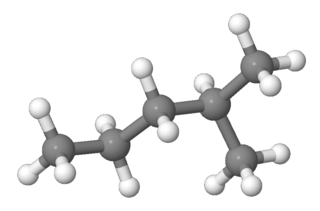
In organic chemistry, an alkane, or paraffin, is an acyclic saturated hydrocarbon. In other words, an alkane consists of hydrogen and carbon atoms arranged in a tree structure in which all the carbon–carbon bonds are single. Alkanes have the general chemical formula CnH2n+2. The alkanes range in complexity from the simplest case of methane, where n = 1, to arbitrarily large and complex molecules, like pentacontane or 6-ethyl-2-methyl-5-(1-methylethyl) octane, an isomer of tetradecane.

Octane is a hydrocarbon and an alkane with the chemical formula C8H18, and the condensed structural formula CH3(CH2)6CH3. Octane has many structural isomers that differ by the amount and location of branching in the carbon chain. One of these isomers, 2,2,4-trimethylpentane is used as one of the standard values in the octane rating scale.

Heptane or n-heptane is the straight-chain alkane with the chemical formula H3C(CH2)5CH3 or C7H16. When used as a test fuel component in anti-knock test engines, a 100% heptane fuel is the zero point of the octane rating scale (the 100 point is 100% iso-octane). Octane number equates to the anti-knock qualities of a comparison mixture of heptane and iso-octane which is expressed as the percentage of iso-octane in heptane, and is listed on pumps for gasoline (petrol) dispensed globally.

Hydrofluoric acid is a solution of hydrogen fluoride (HF) in water. Solutions of HF are colorless, acidic and highly corrosive. It is used to make most fluorine-containing compounds; examples include the commonly used pharmaceutical antidepressant medication fluoxetine (Prozac) and the material PTFE (Teflon). Elemental fluorine is produced from it. It is commonly used to etch glass and silicon wafers.

Pentane is an organic compound with the formula C5H12—that is, an alkane with five carbon atoms. The term may refer to any of three structural isomers, or to a mixture of them: in the IUPAC nomenclature, however, pentane means exclusively the n-pentane isomer, in which case pentanes refers to a mixture of them; the other two are called isopentane (methylbutane) and neopentane (dimethylpropane). Cyclopentane is not an isomer of pentane because it has only 10 hydrogen atoms where pentane has 12.

2,2,4-Trimethylpentane, also known as isooctane or iso-octane, is an organic compound with the formula (CH3)3CCH2CH(CH3)2. It is one of several isomers of octane (C8H18). This particular isomer is the standard 100 point on the octane rating scale (the zero point is n-heptane). It is an important component of gasoline, frequently used in relatively large proportions (around 10%) to increase the knock resistance of fuel.
PubChem is a database of chemical molecules and their activities against biological assays. The system is maintained by the National Center for Biotechnology Information (NCBI), a component of the National Library of Medicine, which is part of the United States National Institutes of Health (NIH). PubChem can be accessed for free through a web user interface. Millions of compound structures and descriptive datasets can be freely downloaded via FTP. PubChem contains multiple substance descriptions and small molecules with fewer than 100 atoms and 1,000 bonds. More than 80 database vendors contribute to the growing PubChem database.

Zirconium(IV) chloride, also known as zirconium tetrachloride, is an inorganic compound frequently used as a precursor to other compounds of zirconium. This white high-melting solid hydrolyzes rapidly in humid air.

3-Methylheptane is a branched alkane isomeric to octane. Its structural formula is CH3CH2CH(CH3)CH2CH2CH2CH3. It has one stereocenter.

2-Methylhexane (C7H16, also known as isoheptane, ethylisobutylmethane) is an isomer of heptane. It is structurally a hexane molecule with a methyl group attached to its second carbon atom. It exists in most commercially available heptane merchandises as an impurity but is usually not considered as impurity in terms of reactions since it has very similar physical and chemical properties when compared to n-heptane (straight-chained heptane).
Methanediol, also known as formaldehyde monohydrate or methylene glycol, is an organic compound with chemical formula CH2(OH)2. It is the simplest geminal diol. In aqueous solutions it coexists with oligomers. The compound is closely related and convertible to the industrially significant derivatives paraformaldehyde, formaldehyde, and 1,3,5-trioxane.

2,5-Dimethylhexane is a branched alkane used in the aviation industry in low revolutions per minute helicopters. As an isomer of octane, the boiling point is very close to that of octane, but can in pure form be slightly lower. 2,5-Dimethylhexane is moderately toxic.

Trimethylstibine is an organoantimony compound with the formula Sb(CH3)3. It is a colorless pyrophoric and toxic liquid. It is synthesized by treatment of antimony trichloride and methyl Grignard reagent. It is produced by anaerobic bacteria in antimony-rich soils. In contrast to trimethylphosphine, trimethylstibine is a weaker Lewis base. It is used in the production of some III-V semiconductors.

2-Methylpentane, trivially known as isohexane, is a branched-chain alkane with the molecular formula C6H14. It is a structural isomer of hexane composed of a methyl group bonded to the second carbon atom in a pentane chain. Using a quantitative structure-activity relationship (QSAR) prediction model, 2-Methylpentane has a research octane number (RON) of 75, motor octane number (MON) of 77, and cetane number (CN) of 29.

2,3,3-Trimethylpentane is a chemical compound in the family of hydrocarbons which has a formula of C8H18. It is an isomer of octane. It has a role as a human metabolite, a bacterial metabolite and a mammalian metabolite. It is an alkane and a volatile organic compound.
Tetramethylbutane, sometimes called hexamethylethane, is a hydrocarbon with formula C8H18 or (H3C-)3C-C(-CH3)3. It is the most heavily branched and most compact of the many octane isomers, the only one with a butane (C4) backbone. Because of its highly symmetrical structure, it has a very high melting point and a short liquid range; in fact, it is the smallest saturated acyclic hydrocarbon that appears as a solid at a room temperature of 25 °C. (Among cyclic hydrocarbons, cubane, C8H8 is even smaller and is also solid at room temperature.) It is also the most stable C8H18 isomer, with a heat of formation 4.18 kcal/mol (17.5 kJ/mol) lower than that of n-octane, a fact that has been attributed to stabilizing dispersive interactions (electron correlation) between the methyl groups (protobranching).

2,3-Dimethylhexane is a structural isomer of octane.

2,3,4-Trimethylpentane is a branched alkane. It is one of the isomers of octane.
3-Methyl-2-butanol is an organic chemical compound. It is used as a solvent and an intermediate in the manufacture of other chemicals.
Propionitrile, also known as ethyl cyanide and propanenitrile, is an organic compound with the formula CH3CH2CN. It is a simple aliphatic nitrile. The compound is a colourless, water-soluble liquid. It is used as a solvent and a precursor to other organic compounds.





















